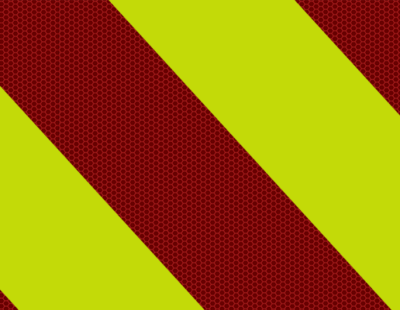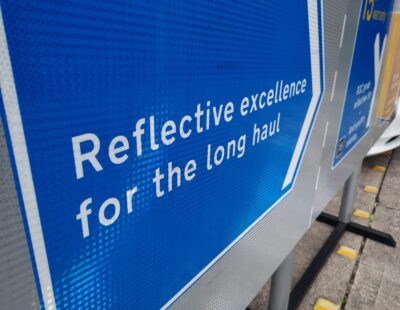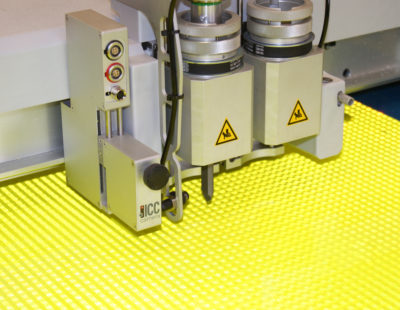Chapter 8 of the UK Traffic Signs Manual, published by the Department for Transport, provides guidance on a wide range of topics related to the planning, design, implementation and operation of temporary traffic management schemes. The purpose of Chapter 8 is to ensure the safety of road users and workers in temporary work zones.
One element covered by Chapter 8 is the use of rear vehicle chevron markings, commonly known as Chapter 8 chevrons. These are specific markings used to make vehicles more conspicuous to other road users, especially when they are stationary or moving slowly on high-speed roads.
In this blog from Lakeside Group, we offer the complete guide to chapter 8 chevron markings. For more information relating to vehicle and traffic safety, take a look at our blog. Articles include, Temporary Traffic Sign Regulations – Everything You Need to Know, How Can Road Safety be Improved, and Understanding UK Police Car Livery.
What are Chapter 8 chevron markings?
Chapter 8 suggests that in order to be optimally effective, vehicles under 7.5 tonnes should feature chevron markings consisting of a series of diagonal stripes in a V-shape pointing upwards (angled between 45 and 90 degrees) measuring no less than 150mm wide. The stripes are usually alternating colours, such as non-reflective fluorescent yellow-green and a R3B grade reflective red. These colours provide high contrast against the background and are easily recognisable, even from a distance, day and night.
Chapter 8 chevron markings should be applied to the rear of the vehicle in a manner that maximises visibility to following traffic. The markings should cover as much of the rear facing portion of the vehicle as possible, without obscuring windows, vehicle lighting or registration plates.
Where chapter 8 chevrons are obscured by a device or equipment mounted on the vehicle, additional high visibility rear markings shall be applied to any face of the device which is displayed to the rear.
In addition to the rear chevrons, Chapter 8 suggests vehicles under 7.5 tonnes should have:
- – a strip of yellow micro prismatic grade reflective material that is a minimum of 50mm wide along either side of the vehicle,
- – red reflective tape applied to all rear facing edges of open doors, guardrails and equipment lockers,
- – “HIGHWAY MAINTENANCE” or “MOTORWAY MAINTENANCE” text, if appropriate for the vehicles use. The text must be non-reflective black, and a minimum of 70mm high for temporary traffic management vehicles and 140mm for all other vehicles carrying personnel or equipment. The text must be placed on a non-reflective or reflective yellow background.
While not legally binding, the recommendations made within Chapter 8 are certainly worth paying attention to. Businesses that do not adhere to Chapter 8 may be at a disadvantage when claiming insurance should an accident occur involving one of their vehicles.
Which vehicles should be fitted with Chapter 8 chevron markings?
Any vehicle working on any public highway (roads with a speed limit of 40mph or greater, typically these include:
- – Road maintenance vehicles: those involved in road maintenance activities, such as highway maintenance vans and road sweepers, often feature chevron markings to alert drivers of their presence and promote safety in work zones.
- – Utility vehicles: those operated by telecom, electricity, or water companies, may also be equipped with chevron markings to increase their visibility while working on or near roadways.
- – Slow-moving vehicles: those that frequently travel at slow speeds, such as agricultural machinery or oversized loads, can benefit from rear chevron markings to reduce the risk of rear-end collisions.
What are the different types of material used for Chapter 8 chevrons?
As discussed above, Chapter 8 chevrons are made up of alternating stripes of red and yellow-green. The red stripes should be R3B grade reflective for nighttime visibility and the yellow-green stripes fluorescent (non-reflective) for daytime visibility.
See Everything You Need to Know About Micro Prismatic Reflective Sheeting for more information on the different classes or grades of micro prismatic reflective sheeting.
Chevrons should be made from materials that can withstand exposure to outdoor elements such as UV radiation, moisture, and temperature variations without significant degradation. This ensures that the markings remain visible and effective over an extended period, even under harsh environmental conditions.
R3B grade metallised micro prismatic reflective red sheeting
Micro prismatic grade sheeting is highly effective at reflecting light from vehicle headlights, making chevrons more visible, especially in low light or nighttime conditions. It also provides excellent visibility over longer distances and is typically used for high-visibility markings on vehicles. By choosing a metallised product fleet managers will benefit from enhanced durability.
We recommend – AURA® 191 metallised micro prismatic grade sheeting
Learn more about metallised micro prismatic products with our blog Air Gap VS Metallised Micro Prismatic Products >
Non-reflective fluorescent yellow-green vinyl
The yellow-green colour is commonly used for chevrons as it offers high contrast against typical road backgrounds and enhances visibility during daytime and inclement weather conditions. Fluorescent materials are especially effective in attracting attention and increasing visibility during daylight hours.
We recommend – AURA® 139 Flexicast™ fluorescent yellow-green vinyl film
All fluorescent sheeting is usually only warranted for a relatively short time scale (2-3 years) because the fluorescence fades when exposed to ultraviolet radiation. Unlike many competitive products, which often completely fade to white, AURA® 139 Flexicast™ will retain a non-fluorescent yellow colour after the fluorescent appearance fades. As such, the product can often be utilised for longer time frames as a non-fluorescent film, even after most of the fluorescence has faded.
Chapter 8 chevron markings from Lakeside Group
By using high-quality materials that meet regulatory standards and guidelines, Chapter 8 chevrons can effectively enhance the visibility and safety of vehicles involved in temporary traffic management, contributing to improved overall road safety for both workers and road users.
At Lakeside Group we supply and manufacture a wide range of reflective and fluorescent products for vehicle and traffic safety purposes. Our team of experts are on hand to offer customers support and guidance with their choice of Chapter 8 chevron materials and any related queries. To find out more about our products and how they can benefit you, contact our team today.



